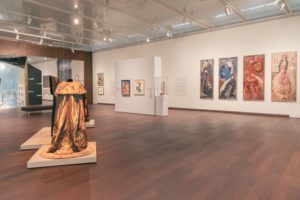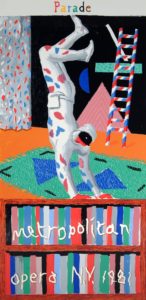“Picasso to Hockney” Spotlights Visual Artists who Also Designed for the Stage
-By JASMINA WELLINGHOFF, Editor-
With Picasso to Hockney- Modern Art on Stage, the McNay Art Museum is shining a bright light on stage set and costume design by showing the work of celebrated artists who also designed for performance. And to show how the curators feel about it, the exhibit is installed in the main Tobin Exhibition Galleries rather than in the smaller gallery where such works are more commonly displayed.

“Most of the works here come from the McNay’s own Tobin Collection of Theater Arts but paired with works from the main McNay collection to show the conversation that you can have between artists and their work in visual art as well as their work for performance,” said, R. Scott Blackshire, the museum curator of Theater Arts. “We are using Picasso and Hockney as middle anchors for the exhibition, with all of our Ballets Russes and pre-Ballets Russes pieces coming before Picasso and all of the contemporary art and theater art after Hockney.”

To which the McNay director Richard Aste added: “We know (the theater arts collection) is one of our greatest strengths, and giving it this kind of real estate signals to the world how important this leg is that we stand on. We are a destination in large part because of this collection.”
Important indeed and also visually rich and fun.
But first, let’s explain the role of the Ballets Russes, alluded above by Blackshire. Founded by impresario Sergei (Serge) Diaghilev in 1909 in Paris, the company dazzled the French capital – and other European cities – with twenty years of innovative, virtuosic ballet productions featuring many Russian themes and showcasing Russian dancers, composers and choreographers. These productions also employed outstanding visual artist to create sets and costumes, among them Alexandre Benois, Leon Bakst, Natalia Gontcharova and Pablo Picasso, all of whom are represented in this great exhibition.
In fact, the physical centerpiece is “the Picasso House,” which is a 3-D reconstruction of the set that Picasso designed for the ballet Pulcinella in 1920, built for the occasion by NcNay’s own installation team. Nearby, hangs the actual painting, suspended from the ceiling, with Picasso’s signature on the back. While under normal theatrical circumstances, you would only see the front of the design, here, you can go around to the back and enter “the house” to experience a set from the other, unpolished side. Picasso’s well-known oil painting Portrait of Sylvette is also nearby.

While Picasso is probably the best-known name in the show, there’s so much more to discover and enjoy. As you enter the large gallery space, you can’t miss groupings of tall paintings on both walls, the work of Russian artist Natalia Gontcharova. On your left will be the four figures – Spring, Summer, Autumn and Winter – that she painted for the 1922 production The Snow Mainden, an opera by Nikolai Rimsky-Korsakov. On the opposite wall are her paintings for Le Coq d’Or (The Golden Cockerel), also a Rimsky-Korsakov opera, for which the choreography was created by another legendary artist Michel Fokine. These are costumes designs but the paintings are works of art that happen to be also used to build costumes. Just pause for a second to imagine yourself being in that theater, enjoying this incredible combination of talents.

Several actual costumes are also placed in that section of the gallery- for instance, Henri Matisse’s Robe for the Emperor for the 1920 production of The Song of the Nightingale – and there are others further down as well, by different artists.
As you progress through the gallery, you’ll also travel through the 20th century and see designs by Fernand Leger, Joan Miro, Giorgio de Chirico, Jean Cocteau, Robert Indiana, Jim Dine, Louise Nevelson, and Lesley Dill, among others. Some pieces are from more recent times like the 1980s and 90s, as well as from the 21st century.
The other titular artist, David Hockney, is among the more contemporary artists in the U.S. who was part of a new wave of creativity in theater aesthetics. He’s represented by several pieces, including the colorful, circus-like designs for Erik Satie’s Parade, staged by the Metropolitan Opera in 1981, and the lovely etching, The Old Guitarist, published in the book, The Blue Guitar (1977). Jim Dines’ charcoal-acrylic-and-spray-paint on paper creations made for the 1987 Houston Grand Opera production of Salome are displayed, too, each image consisting of a single subject, such as a heart, hand or skull.

Two pieces at the very end of the gallery are likely to attract your attention, albeit for very different reasons.. One is Dill’s bright red Ecstasy Dress, a highly dramatic costume featured in her production of Divide Light, a 2008 operatic exploration of the poetry of Emily Dickinson. And the other is her somber, mixed-media artwork titled Vision Catcher, showing a figure with his eyes deliberately covered with long fabric ribbons. It’s a work that makes you pause to think.
Organized in part to attract theater, ballet and opera lovers to the McNay, the show is the brainchild of several individuals. In addition to Blackshire who joined the staff earlier this year, the team includes Timothy James Retzloff, Tobin Theater Arts Fund assistant curator, and former curator Jody Blake. A related exhibit is installed in the museum’s Brown Gallery and the Tobin Theater Arts Gallery.
After closing on Dec. 29, Picasso to Hockney will travel to the Museum of Fine Arts in St. Petersburg, FL, and later to the Dayton Art Institute.
McNay Art Museum, 6000 N. New Braunfels; admission $10-$20; free for children under 12 and military; 210-824-5368, www.mcnayart.org
